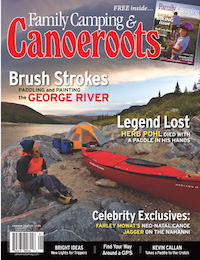Farley Mowat says the spark that brought him into being was kindled in a canoe called Conception on Lake Ontario’s Bay of Quinte. The boat was dark green and paddled by his parents on a sultry August evening in 1920. “My mother,” says Canada’s most colourful writer, “denied this vehemently.”
His father, Angus, just smiled when the topic came up in conversation. But there, the story slips the bonds of earthly logic.
Fast forward to Peterborough, Ontario, 2006. Farley’s nephew had driven him up from Port Hope to have a first peek through the Canadian Canoe Museum.
Farley introduced himself to a startled docent. “I said, ‘My name is Farley Mowat and I’d like to give you a canoe.’ He looked at me as if I’d said my name was Adrienne Clarkson or something. I thought he was going to throw me out. Eventually… they believed me.”
The only catch was that the craft was stored in a barn on Cape Breton Island.
As museum volunteers who had plans to be in Nova Scotia last summer, my wife and I jumped at the call to be couriers. It’s not every day one gets the chance to drop in on a storyteller who has sold 18 million books in 24 languages.
Farley’s wife, Claire, met us outside their seaside summer home. Chester the dog saw us in. The octogenarian sailor, wolf chaser, paddler and storyteller extraordinaire was just surfacing from a siesta. After a quick drink we headed out to the barn where the sailing canoe was stored, and carefully loaded the craft and its various bits—mast, sail, leeboards, splash guards and rudder—before heading back inside to hear the story.
THE REINCARNATION OF CONCEPTION
“It’s a 1921 Peterborough sailing canoe that my father acquired around 1932 in Saskatoon, of all places,” he began. “I was 11 that summer.”
Back then, the Mowats spent summers living in a caravan at a campsite on the banks of the South Saskatchewan River about eight kilometres downstream from town where Farley’s dad worked as librarian. Angus used to commute to work in the canoe, leaving young Farley with vivid memories of his dad portaging his pride and joy from the river through the centre of town to the library.
This pale green canoe had been his first connection to nature, on the sloughs of Saskatchewan. Later, when Farley brought it home to the same Bay of Quinte he was supposedly conceived on, he resolutely rigged the lateen sail before a howling gale on Lake Ontario. Moribund over love gone wrong, Farley was ready to cast his adult fates to the wind and accept whatever verdict the green canoe and the storm handed down.
Through the tempest the canoe delivered him, and a couple of empty rum bottles, safely on the beach near the village of Consecon. He was awoken the following morning by the light of a rising sun, lying beside her, miraculously demon-free. “I wrote a poem about that night that I’d like to give to the museum along with the canoe,” said Farley.
All I could think was, Woah! I hope we don’t get creamed by a transport truck on the way home.
“But was this the green canoe in which you were conceived?” I finally asked. “Well,” said Farley, “Angus called it Vagabond, but sometimes he would slip and call her Conception. To me, she’s Conception.”
By degrees I came to see that whatever its official provenance, this faded green Peterborough, if not the canoe, certainly houses the soul of Farley’s natal canoe. It’s not the canoe Farley Mowat was conceived in. It’s better than that. Vagabond is the reincarnation of Conception, and one of our greatest writers captured the transformation in a poem about his canoe.
James Raffan is currently editing the diaries of paddler Herb Pohl, entitled The Lure of Far Away Places.
 This article first appeared in the Spring 2007 issue of Canoeroots Magazine. For more great content, subscribe to Canoeroots’ print and digital editions here.
This article first appeared in the Spring 2007 issue of Canoeroots Magazine. For more great content, subscribe to Canoeroots’ print and digital editions here.



